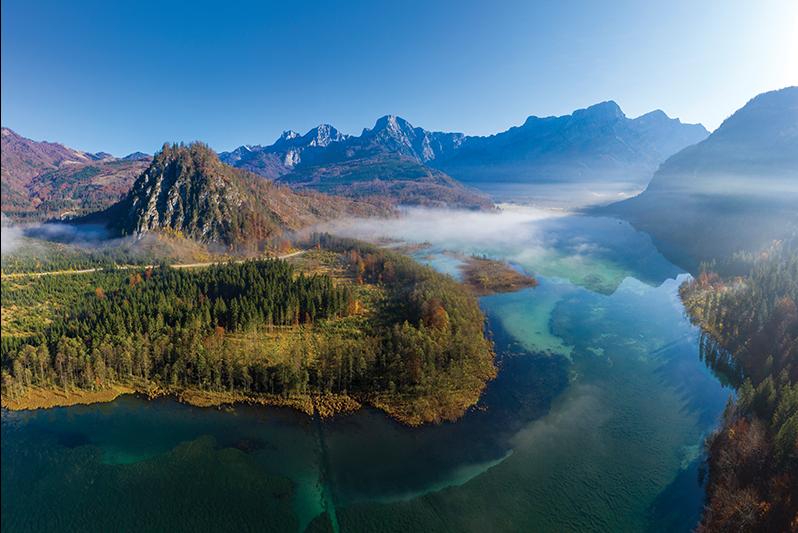
Space-Age Water Conservation
Subheadline
NASA’s need to conserve water in space has long supported terrestrial water-purification techniques
The more difficult a problem is for NASA, the more solutions it eventually produces for the rest of us.
Few challenges are more pressing for the space agency than the need for clean water. Water is heavy — much heavier than the liquid hydrogen and oxygen NASA uses for rocket fuel — and every pound launched into space costs thousands of dollars. So on the space station, nothing is wasted — sweat, urine, and even breath moisture are collected, purified, and recycled as drinking water. But despite its origins, the water astronauts drink is cleaner than what’s available to most people on Earth.
To achieve this, NASA has pushed the cutting edge of water purification since the agency’s early years. And most of these innovations have found plenty of use here on the ground, too, in homes and water bottles, in industrial settings, and in remote locations where safe drinking water is scarce. As the worldwide demand for fresh water grows, this technology becomes more essential every day, as it ensures that people have enough safe water to drink, treats polluted water, and eases the demand on natural aquifers.
These are just a few examples of NASA technology now cleaning water on Earth.
Shower like a Martian
In one recent development, an unlikely partnership between NASA and a Swedish university — with the help of filter technology the space agency helped develop almost 20 years ago — led to the world’s first water-recycling shower.
In 2012, Mehrdad Mahdjoubi, then a master’s student in industrial design at Lund University in Sweden, traveled to Johnson Space Center as part of an annual program to learn about the challenges of designing habitats for astronauts. The focus was on a five-year Mars stay.
Current astronauts, short on water and gravity, take sponge baths, but Mahdjoubi thought spacefarers with feet planted on Martian ground would prefer a real shower. But water on Mars’ desert surface is still scarce, so Mahdjoubi came up with an idea for reusing the flow. “I’d have never thought about doing something like this if I didn’t have that NASA experience,” he says.
To rapidly purify and reuse water, he hit on an especially thorough water filtration technology developed in part with NASA funding, known as NanoCeram.
Other filters have micropores tiny enough to physically filter out bacteria and even viruses, but these are painfully slow. A material invented by Argonide Corporation, however, made up of positively charged microscopic alumina fibers, can remove virtually all contaminants, including bacteria and viruses, despite having significantly larger pores — allowing a much higher flow rate. The positive charge of the fibers attracts and traps microorganisms and other contaminants, which generally carry a negative charge. Activated carbon in the filter aids in snaring particulate, chemical, and soluble contaminants.
Under two Small Business Innovation Research contracts from Johnson in the early 2000s, Argonide optimized its nanofibers for strength and virus adhesion and built, tested, and validated full-scale filter models. Since then, other companies have used the filters in water bottles, portable humanitarian units, and industrial water purification. And now Mahdjoubi has incorporated the filter into a recirculating shower known as Oas — Swedish for “oasis” — built and marketed by his new company, Orbital Systems.
The shower starts with less than a gallon of water and circulates it at a rate of three to four gallons per minute, more flow than most conventional showers provide. The system checks water quality 20 times per second, and the most highly polluted water, such as shampoo rinse, is jettisoned and replaced. The rest goes through the NanoCeram filter and then is bombarded with ultraviolet light before being recirculated. The Swedish Institute for Communicable Disease Control has verified that the recycled water is cleaner than tap water.
And because the reused water is already warm, it takes minimal energy to heat it back to the target temperature.
“There’s a general assumption you can’t do anything about water conservation without compromising your life quality,” says Mahdjoubi. “But we don’t tell people to stop showering, and we don’t destroy their experience. We enhance it with a higher flow rate. The ability to save without sacrifice, I think, is the most important part of our value proposition.”
Orbital Systems, headquartered in Sweden with U.S. offices in Sausalito, California, has raised about $50 million in investments and employs 60 to 70 people.
The company has sold several thousand units, so far mostly to hotel chains and real estate developers, and the showers are becoming available to individual consumers in Sweden, Denmark, and Germany this year. Mahdjoubi plans to expand to North America, Asia, and beyond but first needs to enlist distributors and certify installers. In the longer term, he wants to enable an entire habitat that runs on closed loops, recycling as much and using as little water as possible, just as a Martian habitat would.
“As humans, we’re really good at innovating, but we tend to be quite complacent until we actually have to do it,” Mahdjoubi says. “Designing for Mars forces more creativity.”
Ancient Technology Enters the Space Age
Likewise, NASA engineers had to get creative as soon as the Apollo missions required a long-term water supply. One technique they explored in those early days was the use of silver ions to neutralize bacteria and viruses.
Even then, the concept was not new. Silver has been used to preserve and purify food and beverages since ancient times, but scientists are still researching the best and safest ways to deploy the technique.
The ancients, of course, had no idea how it worked—that when positively charged silver ions dissolve into water or other substances, they bond with and disrupt the negatively charged cell membranes of bacteria and other microorganisms before entering them and wreaking general havoc. But as understanding has improved, so has technology for delivering the ions.
In the 1960s, Johnson, then known as the Manned Spacecraft Center, commissioned an electrolytic silver ion generator to purify water on the Apollo missions. The following decade, in the run-up to the space shuttle missions, the center sponsored a more advanced prototype.
The silver ion-based purifiers never flew on NASA missions, but here on Earth, they’ve given rise to filter systems for home faucets, pools, spas, boilers, hospitals, and more.
One product family with perhaps the most enduring success didn’t even get the technology directly from NASA.
In the 1970s, Arizona inventor Ray Ward requested a technical information package from NASA based on the silver ion system built for the shuttle, which he used to build a prototype tap-water filter. Ward went on to found the Bon Del and Ambassador lines of water filters, which became a $50 million-a-year business. Along the way he also got some help from water treatment company Ionics Inc.
That company, now known as Puronics Water Systems, later used the NASA technology Ward had introduced it to as a starting point for a water softener that wouldn’t breed bacteria.
Today Puronics, headquartered in Livermore, California, sells several lines of whole-house units incorporating the technology, which it calls SilverShield, each with different features and price points. Silver particles in the devices’ filter beds prevent them from breeding bacteria.
Company CEO Scott Batiste says the home units with SilverShield remain the company’s core products, accounting for about 70 percent of its overall business, and the product line has been doing 15 to 20 percent more business each year lately.
“I think it’s a real testament to this technology that we’ve been using it since the late ’80s, early ’90s, and it’s still a growing product line,” he says. “I think NASA should be proud of that, and of course we’re excited about it.”
Using Nature’s R&D Lab
One of the most remarkable — and possibly most effective — water-treatment technologies NASA has explored is a membrane embedded with the same natural proteins that transport water through the membranes of living cells. Known as aquaporins, these proteins are what allow plant roots to absorb water from soil and human kidneys to filter about 45 gallons of blood per day. They can transport water through cell membranes one molecule at a time, while rejecting other substances.
Now companies all over the world are looking at various ways these membranes can be used, including many pilot wastewater treatment projects, whether adding efficiency to existing wastewater treatment facilities or purifying wastewater that until now has gone untreated, polluting groundwater and waterways.
The concept has been pioneered by Danish company Aquaporin A/S, and when Ames Research Center learned what the company was trying to do in 2007, the center became the first paying customer. Ames and the European Space Agency tested the membranes on flights to the International Space Station.
In 2016, Aquaporin delivered its first commercial product, an under-sink filter module for home use.
These operate through reverse osmosis, using pressure to push water through the filters. But the company had even bigger plans for the membranes in forward osmosis, a process that drives itself without any outside influence. With saltwater on one side of the membrane and wastewater on the other, thermodynamics compel the salt to distribute itself evenly throughout all the water in the system. But because salt can’t pass through the membrane, it draws the fresh water through from the other side, leaving only waste.
While forward osmosis is an old technique, the aquaporin proteins’ extremely high selectivity for water molecules gives Aquaporin A/S an advantage. “We have the highest rejection rates and the lowest reverse salt flux rates in the market,” says CEO Peter Holme Jensen. “This is why we can do stuff in forward osmosis that others can’t — because we extract water, and other forward-osmosis technologies extract water and a bit of something else.”
The company, based outside of Copenhagen, has now partnered with companies and other entities around the world on pilot projects or lab tests to try the membranes in almost 60 different forward-osmosis applications. About half of those projects are treating wastewater generated by a range of sources, from landfills to olive oil production to bus depot washing.
One of those is back at Ames, where NASA’s Sustainability Base, one of the federal government’s most environmentally friendly buildings, is trying out Aquaporin HFFO14 forward-osmosis modules for treating gray water — wastewater from sinks, drinking fountains, and other non-sewage sources. This pilot has been running since fall of 2019 and requires less energy and maintenance than the building’s previously existing gray water reclamation system while taking up far less space.
In one of the larger wastewater treatment pilots, Canadian start-up Forward Water Technologies opened a demonstration plant in Alberta last year, using Aquaporin filters to treat water hauled in from oil and gas drilling sites, among other industries.
But Aquaporin is taking particular aim at textile companies, which generate large amounts of highly concentrated wastewater. Most of these are in Asia, where many companies currently don’t treat their wastewater, leading to widespread pollution. Both consumer demand and “zero liquid discharge” requirements some governments are putting in place are changing that, so Aquaporin is supplying filters to Gradiant Corporation, a company that specializes in sustainable water treatment, for use in Asian textile mills. “We have a specific focus on the textile industry because consumers are asking for it,” says Holme Jensen.
Meanwhile, other businesses that do treat wastewater tend to be slow to adopt new technology. “Water companies take 9 to 13 years to adapt to new innovations. If we waited for them, we would go bankrupt,” says Holme Jensen.
But his company has found that some other industries — specifically the food and beverage industry and the field of hemodialysis — are more open to new ideas.
By extracting water in a cold concentration process that uses forward osmosis, companies can increase the alcohol content of beer, create highly concentrated foods, or turn semisolid foods into durable solids. Other techniques work but can change the flavor and texture. “When you do this with forward osmosis, you do it in the gentlest way possible, gently extracting water at room temperature,” Holme Jensen explains.
Between 20 and 30 food and beverage companies — many of them household names — are now running pilots with the company’s forward-osmosis modules, he notes, often with the goal of creating their own patented new products. “For us it was a little surprising.”
And in healthcare, forward osmosis has the potential to make dialysis portable, improving patients’ quality of life, he says. Dialysis patients often spend hours traveling to and from treatment three or four times a week, where they spend another three or four hours bedridden, creating a sedentary lifestyle.
This is partly because hemodialysis a massive water consumer. The process requires about 200 liters of water per treatment—all of which ends up as wastewater. If clean water were extracted from the waste and reused throughout the treatment, he says, dialysis could fit in a backpack.
“We’re testing forward osmosis in a closed water-recycling loop with a lot of players in dialysis,” Holme Jensen says. “Medical device companies understand and pick up on the technology because if you look at how a kidney works, it reuses water in a closed loop.”
And after all, the mechanism that makes that closed loop work is the aquaporin protein.
Mike DiCicco
Managing Editor

Water is one of Earth’s most precious resources. For many years, technology invented or supported by NASA for life-support systems in space has been used to both clean and conserve water on the blue planet. Credit: Getty Images
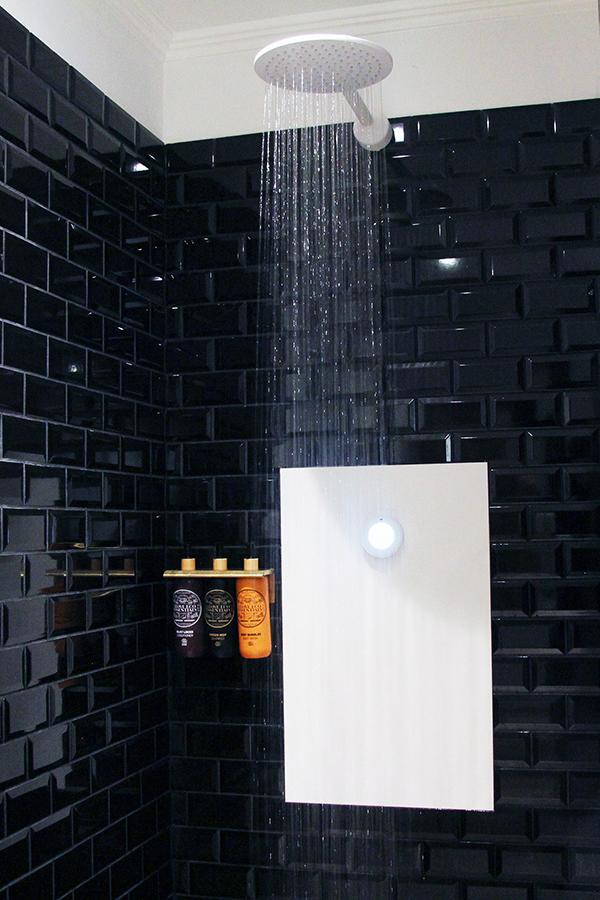
Orbital Systems’ Oas shower is the world’s first water-recirculating shower. It was inspired by a university’s partnership with NASA and is enabled by a filter technology NASA helped fund with an eye toward improving astronaut life-support systems. Credit: Orbital Systems
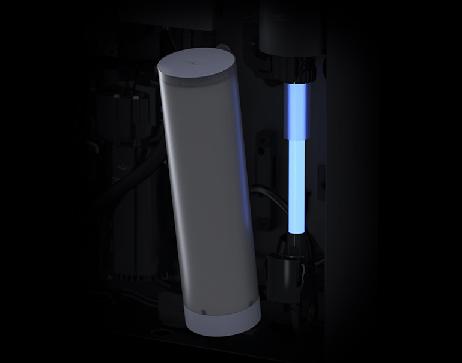
The combination of a NanoCeram filter, left, and an ultraviolet light lets the Oas shower purify and recycle all but the dirtiest water. Credit: Orbital Systems
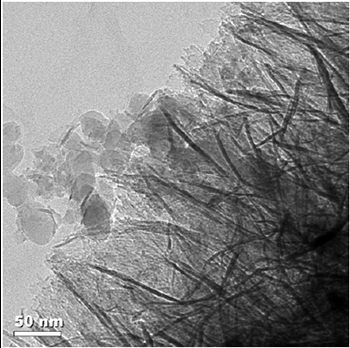
Microscopic nanoalumina particles coat a glass fiber in NanoCeram filter technology. The positively charged particles attract and trap bacteria, viruses, metals, organic material, and other contaminants, such as the virus-sized silica particles seen here.
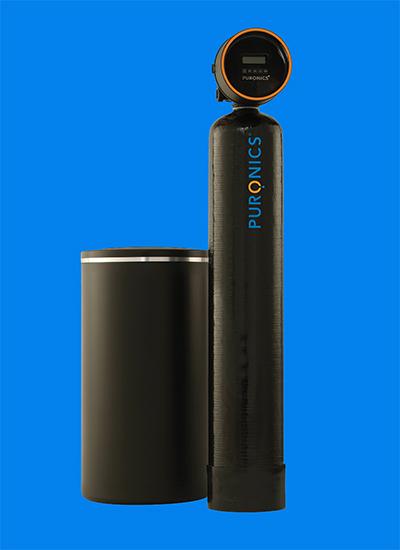
The Puronics Defender whole-house water conditioner uses silver-ion technology based on work NASA did in the run-ups to the Apollo and space shuttle missions. Positively charged silver ions neutralize bacteria in the unit’s filter beds. Credit: Advanced Cascade Water Systems Inc.
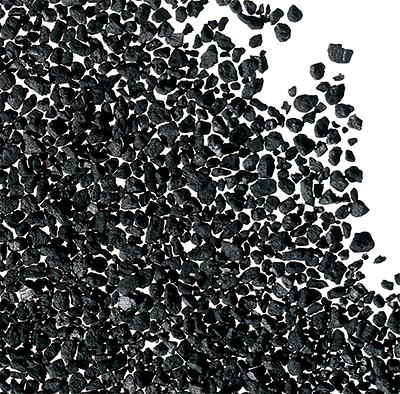
Carbon impregnated with silver ions forms the filter bed for most of Puronics’ product lines. Credit: Puronics Water System Inc.
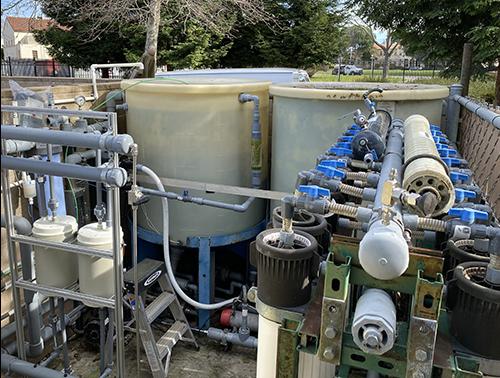
In the gray water reclamation system at Ames Research Center’s Sustainability Base, the two beige Aquaporin HFFO14 forward-osmosis modules on the left have as much filtration capacity as the entire legacy system on the right. Credit: Aquaporin A/S
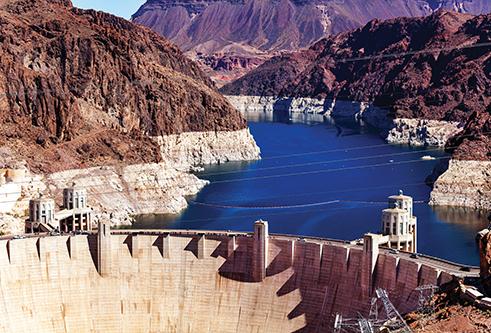
The water level of the Lake Mead reservoir behind Hoover Dam between Nevada and Arizona is chronically low due to years of drought and human demand for the water. As the human population continues to grow and fresh water sources shift or deplete, technology for cleaning and conserving water takes on greater importance. Credit: Getty Images













